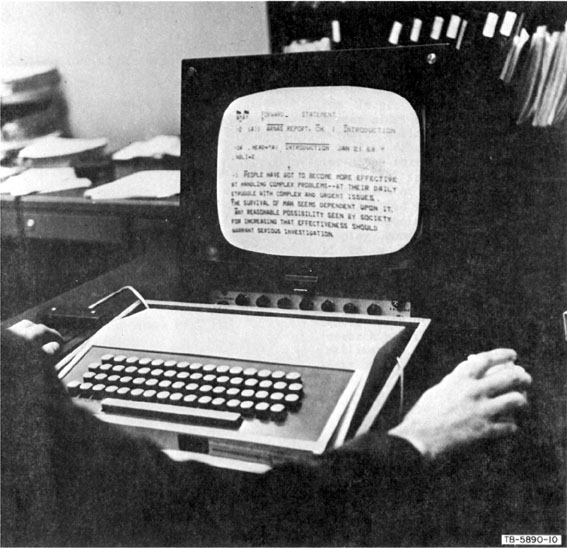
Dedication
Welcome to the starting page for the Augmnetaion Research Efforts.
These efforts at the University of Pittsburgh are dedicated to the groundbreaking
work of Douglas Engelbart and hsi work through the second half of the twentieth
century. Beginning in the 1960's, Engelbart set out to devise a series
of systems that would augment human intellectual activity. We have
begun, almost a half century later, to appreciate the significance of his
work. There are a number of papers one should read including Augmenting Human Intellect: A Conceptual Framework.
Many of these have been made available by Engelbart through his Bootstrap Institute.
The image above, from 1968, shows an early workstation by Engelbart using
a mouse functioning hypertext.
Focus
Augmentation is both easy and hard. If we want systems to know what
we know and act on our behalf without intervention and to be perfect in executing
our wishes, that is hard. It has been one of the goals of artificial
intelligence research for the last 30 years. Efforts today, such as
Lenat's continue to strive in this direction. Other efforts are less
ambitious. Eyeglasses augment our ability to see. Automobiles
augment our abilty to move. Hammers augmnet our ability to drive pointed
objects through permeable material, etc. A cookie in a webbrowser may
augment our ability to order an item online. A set of bookmarks in
our browser may augment our ability to recall websites we liked -- or wanted
to remmeber.
All of these things constitute augmentation. The efforts of this research
group are on finding ways to use digital technology to augment intellectual
activity when groups of individuals are involved. We place no constraints
on what activity or what technology. Our projects range from collaborative
editing, to infomration marlketplaces, to the semantic web. A few of
these efforts are referenced below.
Projects
The links to the left provide access to information on some of the related
projects. One of the earliest projects was a Computer Augmneted System for Collaborative
Authoring and Document Editing -- CASCADE. This project was finished
in 1999 but is gaining new life in the form of a system for collaborative
annotation of three and four dimenisonal spaces. We have been spending
a lot of time recently on smart spaces. We have started simply and
have developed efforts related to Role Assured Publicly Accessible Information
(RAPAI). The other major effort of the group relates to the semantic web and
various manifiestations of its presence.
